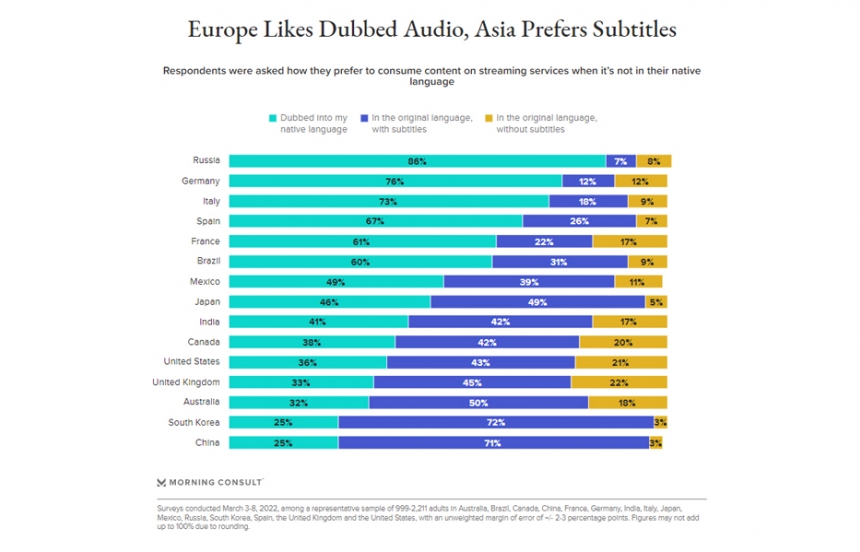Subtitling vs Dubbing: Which is Right for Your Audience?
Updated: December 16, 2024
Discover 3Play’s Revolutionary AI Dubbing Solution
When it comes to watching their favorite foreign language films, many viewers choose between two main viewing options – subtitling vs. dubbing. These two options are largely dependent on the viewer, where they are from, and their viewing preference.
No matter your preference on the subtitling vs. dubbing debate, as a producer and creator of foreign language video content, it’s important to distinguish between the two and understand which one fits best into your content workflow.
In this blog post, we’ll discuss the differences between subtitling vs. dubbing and their respective workflows. Ultimately, you’ll be better equipped with the knowledge to make the most informed decision about which one is right for your organization.
Subtitling vs. Dubbing: The Key Differences
Dubbing involves replacing the original audio track of a video with a translated version in a different language, allowing viewers to hear dialogue in their preferred language. Subtitling, on the other hand, provides a textual representation of the original audio, enabling viewers to understand the dialogue while still hearing the original language. Subtitles focus solely on translating spoken language, excluding sound effects.
What is Dubbing?
While some viewers prefer watching videos with subtitles, others prefer following along with the dialogue in their native language.
Although similar, dubbing is not the same as a voiceover, which is used to inform viewers about the story and character and is used for creative storytelling purposes.
Dubbing should fit effortlessly into the video and for the most part, should feel seamless to viewers. Here’s an example of the American television sitcom, Friends, dubbed in German.
There are many reasons why viewers prefer to watch videos with dubbing. Some of the benefits include:
- Portrays the emotion and tone of the original audio
- Creates an immersive and engaging experience
- Viewers can solely focus on watching the video instead of reading text
- Useful for people who struggle with reading or cannot read
- Viewers can multitask while listening to the audio
- Easier to censor explicit content of the original audio
What is Subtitling?
In many parts of the world, like in Europe, the terms subtitles and captions are used interchangeably. However, in the United States we differentiate between the two.
Subtitling is the process of translating the original audio within a video into another language. Subtitles are a textual representation of the audio and they’re intended for viewers who can hear the audio but cannot understand the language. They solely communicate the spoken language and not other elements like sound effects.
Captions, on the other hand, convey all audio elements, including sound effects, speaker identifications, and non-speech elements. Captions are written in the source language of the video (e.g. if the original audio is in English, the captions are written in English).
Here’s an example of a short foreign language film with English subtitles.
There are many benefits of subtitling, such as boosting SEO and accessibility for d/Deaf and hard of hearing viewers. and reasons why a viewer might prefer subtitles. Some of them include:
- Prefers to read along with the subtitles
- Learning a new language
- Aids in focus and comprehension of the content
- Helps viewers with spelling and grammar
- Makes it easier for viewers to learn another language
The Ultimate Guide to Subtitles [FREE Download]
Subtitling vs. Dubbing: The Differences in Viewer Engagement
When it comes to connecting with audiences in their native tongues, preferences for dubbing versus subtitling can vary by country. A study by Morning Consult revealed that respondents from Russia, Germany, Italy, Spain, Mexico, Brazil, and France largely favored dubbing for foreign language content, suggesting a preference for a more immersive experience. Conversely, a greater majority of respondents in China, South Korea, India, and Japan expressed a liking for subtitles. This divide highlights the importance of catering to diverse preferences in an increasingly globalized media landscape.
While regional preferences are strong indicators of subtitling versus dubbing, the type of content you produce can influence which format is better for engagement. In a survey conducted by Preply on viewing habits for entertainment content, 84% of respondents agreed that “subtitles retain the cultural authenticity of the content,” and they preferred to “hear the original actors’ voices and intonations.”
For eLearning content, dubbing provides a more immersive experience, enhancing the emotional impact and comprehension of the content.
Subtitling vs. Dubbing: The Differences in Workflow
No matter the viewers’ preference, when it comes to the implementation of subtitling vs. dubbing, the two are very different. Before deciding on which is best for your organization, you’ll first want to consider the costs, editing, publishing, and quality.
The Dubbing Workflow
Traditional dubbing is a complex process that typically requires multiple experts and steps.
- Create a script: You’ll need to translate the dialogue into another language and synchronize the dub with the original language. Experts are recommended, as they’ll ensure the dialogue is accurately translated and synced.
- Choose voice talent: Traditional dubbing requires voice talent. There are typically voice actors who specialize in dubbing and understand the process.
- Recording: The recording process requires the most technical expertise and involvement of translation specialists, voice talent, and sound engineers to guarantee success. A professional recording studio with high-quality equipment is recommended.
- Post-production: Finally, you’ll have to layer the completed dubbed audio track into the video. For this step, you’ll need both a sound and editing expert.
- Publishing: Ensure the vendor you work with offers a variety of file formats that work for your publishing needs. In some cases, the vendor may be able to publish your content on your behalf.
To save on costs, the dubbing process must be well-planned and executed properly the first time around. If you have to book multiple sessions, it will cost more money, time, and effort.
Traditional dubbing can be an expensive process. According to Bunny Studio, a simple video can cost as much as $75 per minute. The more complex your video content is, the more you may expect to pay. With traditional dubbing being such an intricate process, the costs make sense – especially if you decide to work with high-quality professionals.
Innovation in Dubbing Solutions
While the process of traditional dubbing can be lengthy, complicated, and costly, new technology such as artificial intelligence (AI) and synthetic voice creation has allowed much innovation in the space of dubbing solutions.
One such solution, AI dubbing or automated dubbing, refers to the process of using artificial intelligence and machine learning algorithms to automatically generate dubbed audio tracks for video content. This technology analyzes the original dialogue and generates corresponding audio in the desired language.
Due to its automated nature, AI dubbing offers greater flexibility and affordability than traditional dubbing. However, AI dubbing solutions that only use AI for the entirety of the process often result in quality issues that may negatively impact the end-user experience.
When selecting vendors that offer AI dubbing solutions, be sure that their process involves both humans and AI technology. An AI dubbing solution that’s driven by humans and supported by AI technology will ensure the best of both worlds – high-quality dubs and lower costs that work within your organization’s budget.
High-quality and cost-effective AI Dubbing →
The Subtitling Workflow
There are two main ways to create subtitles – the DIY route or translation vendor. Similar to creating captions, subtitling on your own can be a costly and time-consuming process.
The DIY process requires manually transcribing the audio in the original language, which could take 4-5 times longer than the length of the video. It also requires doing the translations on your own, ensuring they’re both accurate and in the same cultural context as the original audio.
With a translation vendor, you’re able to cut down on cost and time, especially if your organization produces a large amount of video content. A good vendor will be able to take on the responsibility of the transcription and translation process and deliver the final output to you or automatically upload it to your video.
The cost of subtitling can vary depending on the process you choose to undergo.
At first glance, the DIY route seems like the cheaper option. However, once your video content needs increase, it becomes exponentially more expensive and harder to maintain quality, consistency, and efficiency. It’s only recommended to DIY your translations when you have a very small quantity of video content.
With a vendor, the cost of translations can range from $10-26 per minute depending on the language. When working with a translation vendor, be sure that the company values quality. Although some vendors are lower in cost, they could be sacrificing accuracy which will ultimately cost more money down the road.
Choosing the Right Option for Your Organization
So, where do you stand on subtitling vs. dubbing? Both certainly offer benefits to your organization and to the viewer experience. Whether your company decides to go with subtitling, dubbing, or a combination of the two, we believe it’s important to empower you with the most essential information to make an informed decision.
3Play Media has provided thousands of our customers with high-quality, accurate localization services. As a one-stop, full-service video accessibility company, 3Play Media offers localization services as a seamless addition to your other video accessibility needs.
Looking to get started with localization services? Our team of experts is here to help.
Editor’s Note: This post was originally published by Elisa Lewis in May 2021 and has been updated for freshness, accuracy, and comprehensiveness.







